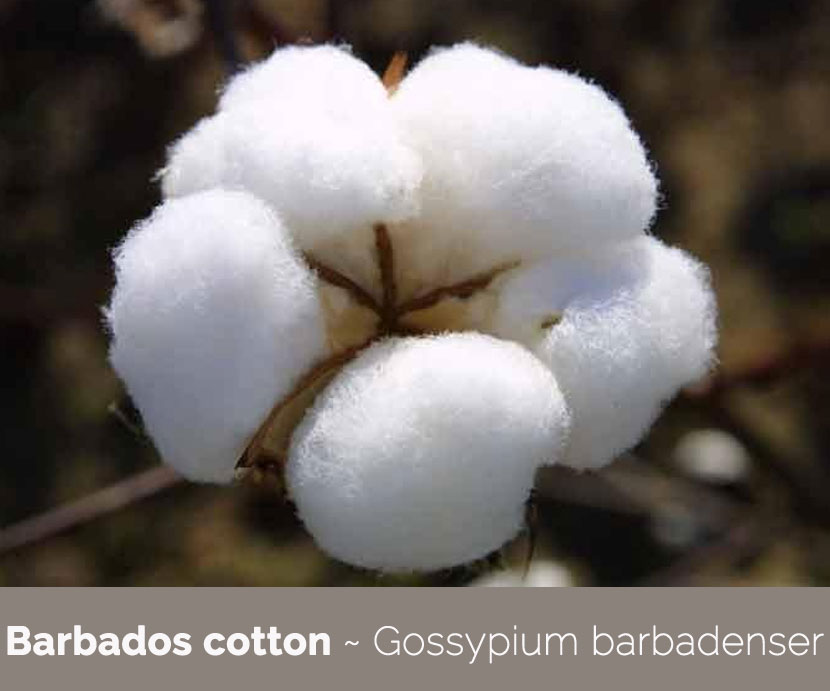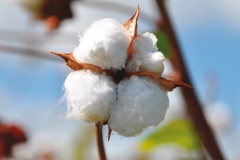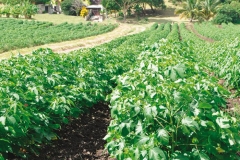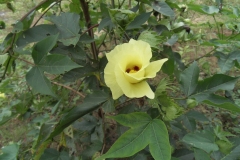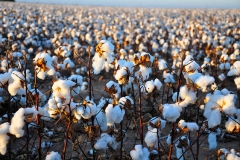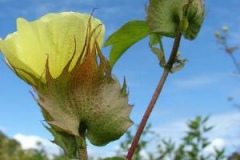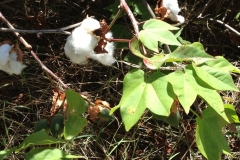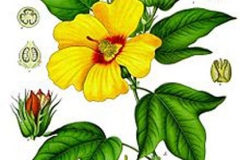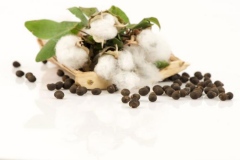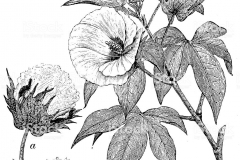Plant Description
Barbados cotton is a frost-sensitive, tropical, evergreen, perennial plant that grows about 3 meters tall. The plant is found growing in desert climates and under irrigation. The plant can be grown on a variety of soils from light sandy soils to heavy alluvium and rendzina-type clays. Soils must be permeable to water and to roots to a depth of at least 100 cm. The plant has robust tap root, often with four rows of lateral roots. The plant has few or many strong, ascending stems that become more or less woody. The plant is widely grown in many tropical to warm temperate regions for the seed floss which is used to make cloth. It is also sometimes grown as an ornamental plant. An annual form of the plant, known as ‘Sea Island’ cotton, yields the highest quality lint of any cotton.
Barbados Cotton Facts
| Barbados cotton Quick Facts | |
|---|---|
| Name: | Barbados cotton |
| Scientific Name: | Gossypium barbadense |
| Origin | Coasts of Peru and Ecuador |
| Shapes | Ovoid to fusiform leathery, spherical capsule 3.5–6 cm long |
| Health benefits | Beneficial for high blood pressure, abdominal cramps, menstrual problems, skin rash, children's cramps, eye affections, jaundice and constipation |
| Name | Barbados cotton |
|---|---|
| Scientific Name | Gossypium barbadense |
| Native | Grows naturally on the coasts of Peru and Ecuador. It was domesticated in north-western South America |
| Common Names | American Pima cotton, American-Egyptian cotton, Barbados cotton, Barbados tree cotton, Brazilian cotton, Egyptian cotton, Extra long staple cotton, Gallini cotton, Kidney cotton, Long-staple cotton, Peruvian cotton, Pima cotton, Upland cotton, Sea Island Cotton, Creole cotton, cotton, kidney cotton, Egyptian cotton |
| Name in Other Languages | Afrikaans: Langvesel katoen Arabic: Al qutn el masri (القطن المصري), Qutn beru (قطن برو), Qutn geziret el bahhr (قطن جزيرة البحر), Qutn masri (قطن مصري) Catalan: Cotoner Pima Chamorro: Algodon, atgodon Chinese: Li he mu mian, Mu mian, hai dao mian Cuba: Algodón, algodón criollo Danish: Vestindisk bomuld, Barbados-Bomuld Dutch: Amerikaanse katoen English: American Pima cotton, American-Egyptian cotton, Barbados cotton, Barbados tree cotton, Brazilian cotton, Egyptian cotton, Extra long staple cotton, Gallini cotton, Kidney cotton, Long-staple cotton, Peruvian cotton, Pima cotton, Upland cotton, Sea Island Cotton, Creole cotton, cotton, kidney cotton, Egyptian cotton Fijian: Vauvau, vauvau ni vavalangi Finnish: Länsi-intianpuuvilla French: Coton à longue soie, Coton des Indes Occidentales, Cotonnier d’Egypte, cotonnier créole German: Baumwollpflanze, Westindische Baumwolle, sea island Baumwolle Greek: Thavnodes vamvaki (θαμνώδες βαμβάκι) Haitian: Pye koton Hawaiian: Kī‘ailana, pulupulu, pulupulu haole I-Kiribati: Te baobao, te baubau Italian: Cotone Egiziano Mangarevan: Komiro ina, komorio iva Maori (Cook Islands): Vavaī, vavaī papa‘ā, vavai Marquesan: Aavaih, uru Marshallese: Kotin Nauruan: Duwoduwo Niuean: Vavae Pohnpeian: Koatun Portuguese: Algodoeiro-americano, Algodoeiro-crioulo, Algodoeiro da costa, Algodoeiro da Guiné, Algodoeiro da praia, Algodoeiro das Barbadas, Algodoeiro das Índias ocidentais, Algodoeiro de Pernambuco, Algodoeiro-egipcio, Algodoeiro folha pareira, Algodão do pantanal Russian: Khlopchatnik peruanskij (Хлопчатник перуанский) Samoan: Vavae, vavae pālagi Spanish: Algodón, Algodón americano, Algodón de las Indias, Algodón de las islas, Algodón de mata, Algodón de riñón, Algodón jujure, Algodón peruano, Algodón rojo de Perú, Algodón vicuña, Algodonero de las Barbadas, Algodonero egipcio, Algodonero de las Barbados, Algodon de las Indias Occidentales Swahili: Pamba ya kisendji Swedish: Västindisk bomull Tahitian: Evavai, vavai, vavay Tongan: Vavae, vavae tonga Thai: Faai chan (ฝ้าย ชัน), Fai dok (ฝ้ายดอก), Fai thet (ฝ้ายเทศ) Turkish: Mısır pambuk fidanı, Peru pambuk fidanı, akaltın Uzbek: Janubiy amerika gʻoʻzasi Wallisian: Vavae, vavai |
| Plant Growth Habit | Frost-sensitive, tropical, evergreen, perennial plant |
| Growing Climates | Performs best in desert climates, under irrigation |
| Soil | Can be grown on a variety of soils from light sandy soils to heavy alluvium and rendzina-type clays. Soils must be permeable to water and to roots to a depth of at least 100 cm |
| Plant Size | About 3 meters tall |
| Root | Tap root robust, often with four rows of lateral roots |
| Stem | Few or many strong, ascending stems that become more or less woody |
| Leaf | Leaves spirally arranged; stipules linear, lanceolate or ovate, in flowering shoots often broadly ovate to orbicular and auricled at base, 1–5 cm long |
| Flower | Flowers solitary, usually on sympodial branches; pedicel shorter than petiole, not articulated, sharply trigonous, usually bearing nectaries below the insertion of the epicalyx segments |
| Fruit Shape & Size | An ovoid to fusiform leathery, spherical capsule 3.5–6 cm long, beaked, glabrous |
| Seed | Pear shaped, 8–10 mm long, with an acute hilum, black to dark brown, with a dense covering of long, fine, white woolly hairs |
| Propagation | By Seed |
| Culinary Uses |
|
Leaves
Leaves are spirally arranged; stipules linear, lanceolate or ovate, in flowering shoots often broadly ovate to orbicular and auricled at base, 1–5 cm long; petiole ½ the length of the blade; blade orbicular to broadly ovate in outline, 8–20 cm in diameter, 3–7-palmately lobed with central segment largest, upper leaves sometimes not segmented, lobes ovate to lanceolate, base cordate, margin entire, pedately 3–9-veined, with 1–3 central veins with an elliptical nectary slightly above the base beneath.
Flowers
Flowers are solitary, usually on sympodial branches; pedicel shorter than petiole, not articulated, sharply trigonous, usually bearing nectaries below the insertion of the epicalyx segments; epicalyx segments (bracteoles) 3, erect, appressed against corolla or fruit, orbicular to ovate, 4–6 cm long, at base cordate and strongly auricled, with 5–17 acuminate teeth, persistent; calyx cupular, 8–10 mm long, with 5 obtuse short teeth at truncate apex, densely gland-dotted, bearing 3 nectaries outside at the base, splitting after flowering; corolla usually yellow with a dark red or purple spot at the base, petals 5, imbricate, obovate, 5–8 cm long, truncate and emarginate at apex; stamens numerous, forming an erect column 2.5–4 cm long, filaments short, anthers 1-celled; pistil with 3–5-celled ovary and one short style with clavate, 3–5-sulcate stigma.
Fertile flowers are followed by an ovoid to fusiform, leathery, spherical capsule 3.5–6 cm long, beaked, glabrous, densely pitted, black, opening loculicidally, 3-celled with several seeds per cell. Seeds are pear shaped, 8–10 mm long, with an acute hilum, black to dark brown, with a dense covering of long, fine, white woolly hairs (lint or floss) and a fine, short tomentum (fuzz) everywhere or only at the hilum or absent
Traditional uses and benefits of Barbados cotton
- Leaves are used for high blood pressure, abdominal cramps, menstrual problems, etc.
- Seeds are used for diarrhea and thrush.
- Root is abortifacient, emetic and emmenogogue.
- An infusion of the root bark is used to treat difficult or irregular menstruation.
- The pulverized roots are used to procure an abortion.
- Stem bark is used in a preparation to strengthen the womb.
- Leaves are antipruritic, diuretic and hypotensive.
- Leaves of the red variety of cotton are used for treating high blood pressure, abdominal cramps and pain, menstrual problems, painful ovaries, and difficult expulsion of afterbirth.
- Applied externally, the leaves are softened in oil to make a poultice that is used to soothe an overheated person.
- An infusion of the leaf juice is used to treat skin rash and children’s cramps.
- Juice from macerated leaves is used as wash to treat itchy skin.
- Juice from the macerated leaves is warmed and used as a medicament for ‘bush yaws’.
- Flower buds are used as an auricular analgesic.
- Seeds are crushed, and the juice given to babies as a treatment for thrush.
- The seed fibers are laxative and pectoral.
- They are used to treat diarrhea and thrush.
- Applied externally, they are used to make a dressing on wounds.
- Pressed cotton cake contains gossypol, which is used clinically as a male contraceptive.
- Gossypol is a toxic polyphenolic bisesquiterpene which may have antifertility and antiviral properties.
- Gossypium barbadense is widely used in African traditional medicine.
- Leaf infusion is used as eyewash for the treatment of eye affections in Senegal.
- Dampened fiber is used as a wound dressing, and fiber soaked in oil is used for drawing in Côte d’Ivoire.
- Leaf juice diluted with water is used as eye drops for the treatment of conjunctivitis in Mali.
- Leaf juice is taken for the treatment of cough, dystocia and vertigo, and a decoction of the leaves with those of Pergularia daemia (Forssk.) Chiov. is taken against convulsions in Benin.
- Leaf decoction is taken for the treatment of jaundice, pounded leaves are used in poultices against stomach-ache and constipation, and seed oil is used against otitis in Cameroon.
- Leaf maceration is taken against gonorrhea and as an emetic, while the sap is considered emollient and externally applied against itch in Gabon.
- Leaf sap is instilled in the ear for the treatment of otitis, leaf decoctions are drunk against cough, and the leaf is rubbed on the body to cure scabies in Congo.
- Leaf infusion is drunk for the treatment of colds, bronchitis, rheumatism and hemorrhoids, and kept in the mouth to treat dental caries and gingivitis in DR Congo.
- Pounded leaves are applied on cuts, abscesses and used for the treatment of leprosy.
- Pulped young shoots are used against palpitations, and the fiber in dressings on wounds.
- Lint is used as dressing on sores in Kenya.
https://www.youtube.com/watch?v=2ZeXlkM-LiM
Other Facts
- Fiber obtained from the seed floss is the longest of any cotton species.
- Cotton fibers have a wide range of used including making clothes; rubber-tyre fabrics; stuffing material for pillows, cushions etc.; surgical dressings, making twine and ropes, carpets etc.
- Low-grade oil is used in the manufacture of soap, lubricants, sulphonated oils and protective coatings.
- Residual seed cake, decorticated or undecorticated, is an important protein concentrate for livestock.
- Low-grade cake is used as manure.
- Whole seed may also be used as cattle feed.
- Cotton seed hulls are used as roughage for livestock and as bedding and fuel.
- Dry stalks are excellent as household fuel.
- Fuzz from seed delinting after ginning is used in upholstery, felt, paper and explosives.
- Fiber of Gossypium barbadense is locally used for weaving articles such as waistbands, neckerchiefs and armlets in West Africa.
- It is used for making coarse textiles, cords, string, fishing nets and straps in DR Congo.
References:
https://www.itis.gov/servlet/SingleRpt/SingleRpt?search_topic=TSN&search_value=21710#null
http://www.hear.org/pier/species/gossypium_barbadense.htm
https://npgsweb.ars-grin.gov/gringlobal/taxonomydetail.aspx?id=17904
https://pfaf.org/user/Plant.aspx?LatinName=Gossypium+barbadense
https://plants.usda.gov/core/profile?symbol=GOBA
http://www.theplantlist.org/tpl1.1/record/kew-2831007
https://en.wikipedia.org/wiki/Gossypium_barbadense
https://www.cabi.org/isc/datasheet/25794
https://uses.plantnet-project.org/en/Gossypium_barbadense_(PROTA)
https://www.wikidata.org/wiki/Q311515
https://gd.eppo.int/taxon/GOSBA
https://www.prota4u.org/database/protav8.asp?g=pe&p=Gossypium+barbadense+L


